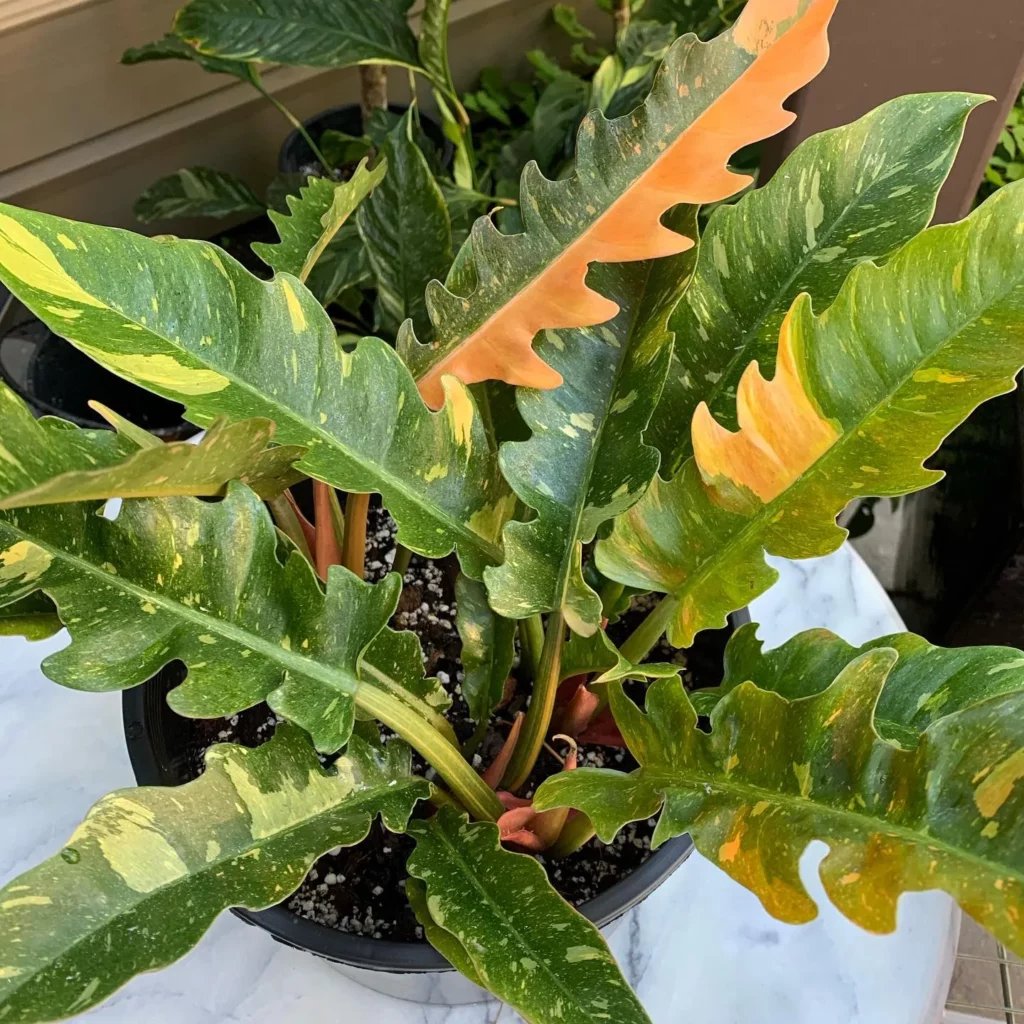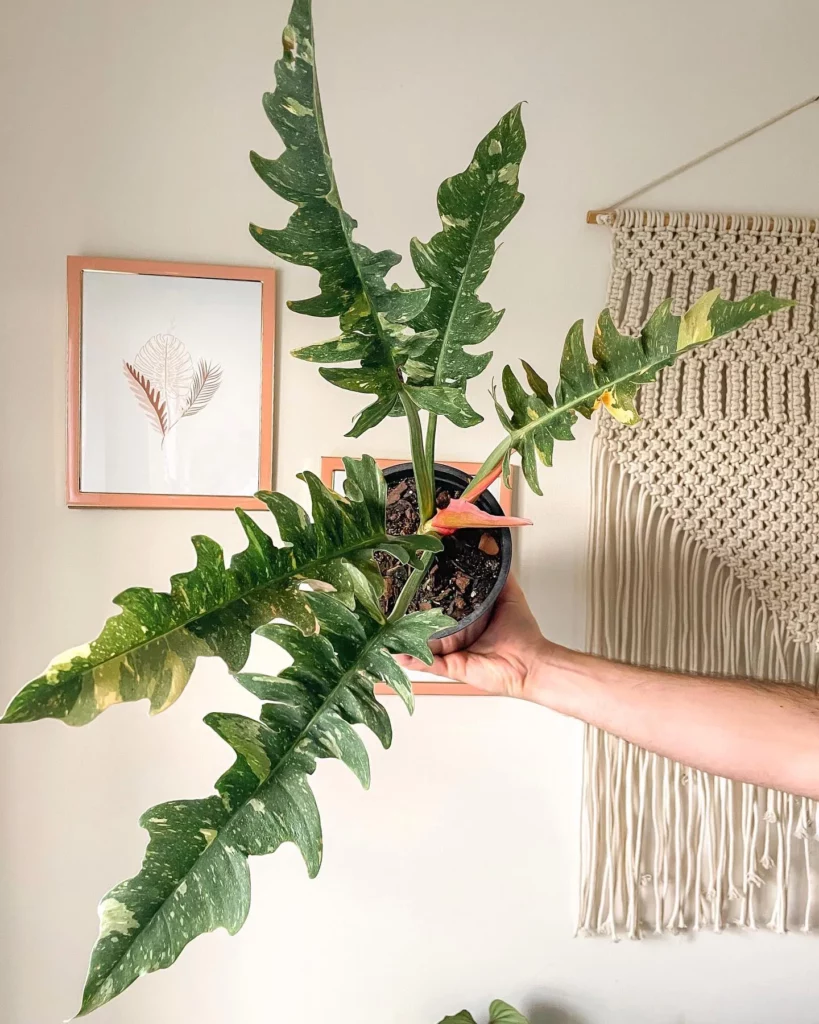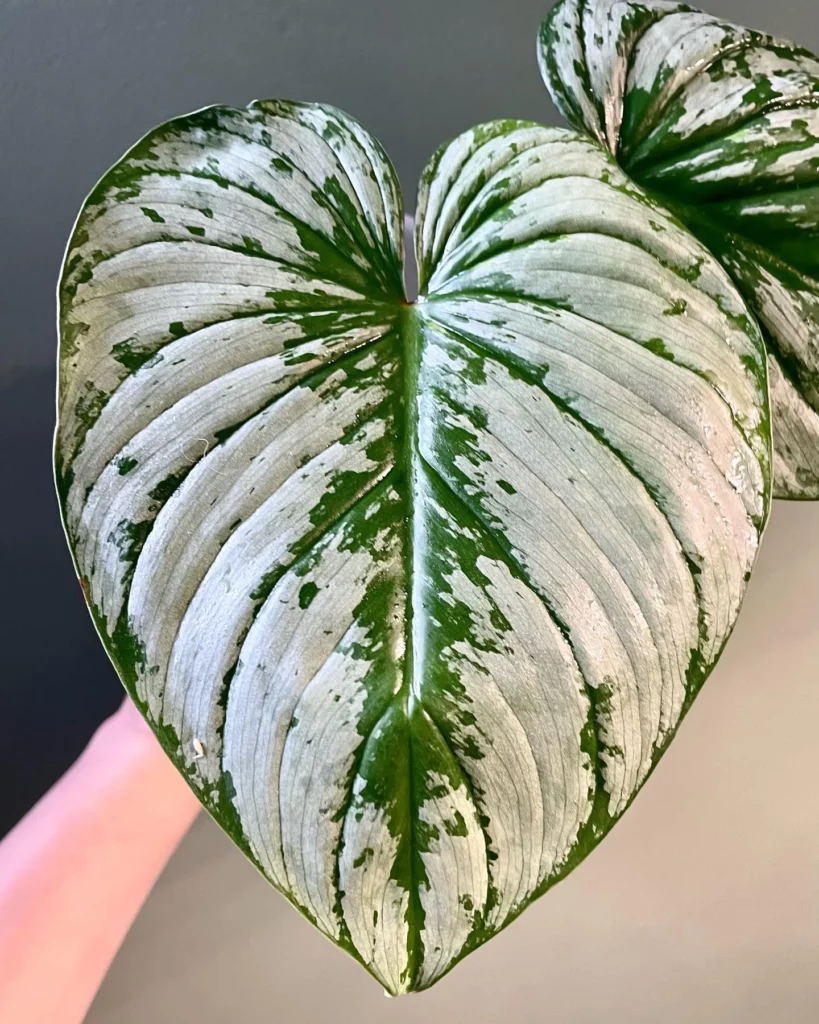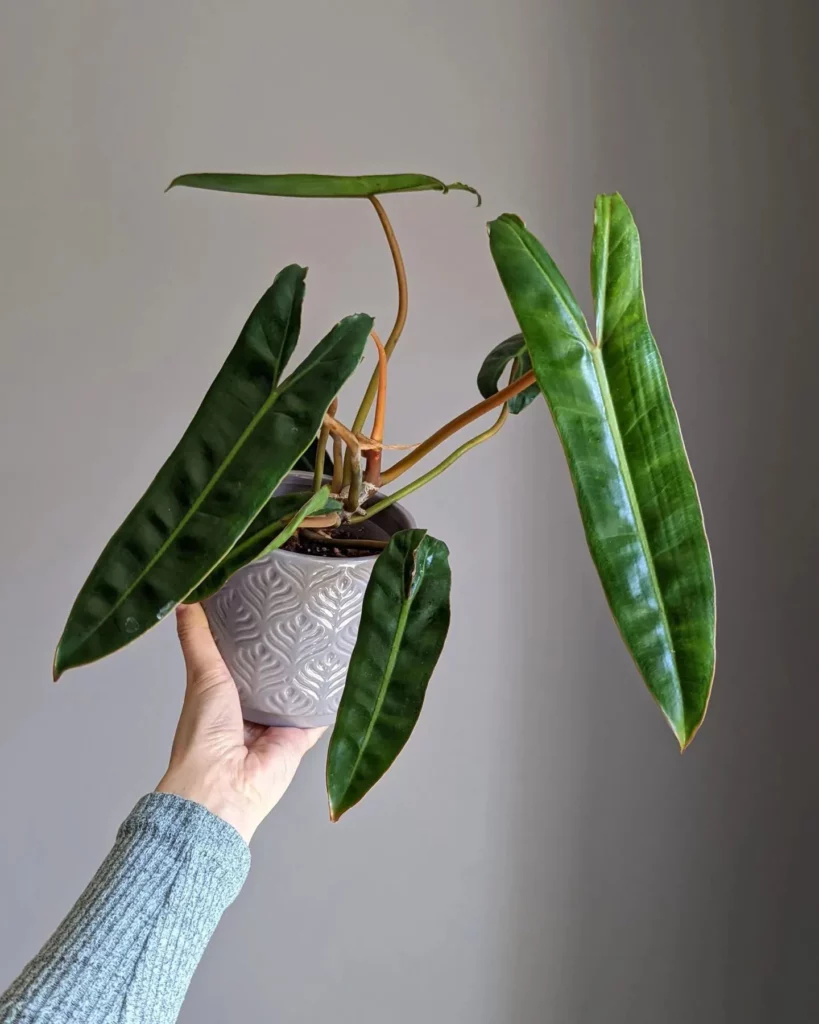The scientific name for this plant is Philodendron bipinnatifidum x selloum. One interesting fact about the genus Philodendron is that its name comes from Greek words “philo,” meaning love or affection, and “dendron,” meaning tree.
The Ring of Fire variety is a hybrid created by crossing two Philodendron species. It has inherited desirable traits from both parents, resulting in an attractive and unique plant with dark green leaves that have bright pink variegation around their edges.
Appearance



The leaves are dark green with lighter green spots, and they have striking pink edges that give this plant its name. The leaves form an attractive rosette pattern, making it the perfect choice for any indoor space looking for a touch of tropical beauty.
One thing that sets the Philodendron Ring of Fire apart from other philodendrons is its compact size.
Unlike some other species that can grow rather large, the Ring of Fire maintains a relatively small and manageable size – perfect for those with limited space or who simply prefer smaller plants.
With proper care, this plant can reach heights of around 2-3 feet.
Its unique coloring makes it an eye-catching addition to any room in your house while adding just enough tropical flair without overwhelming the space.
How To Grow



Growing Philodendron Ring of Fire may seem intimidating to many gardeners, but these tropical beauties are actually quite easy to care for with the right growing conditions.
First and foremost, it is important to understand that Philodendron Ring of Fire thrives in bright but indirect light.
So make sure you place them near a window where they can get plenty of diffused sunlight throughout the day. Direct sunlight can scorch their leaves, so it’s best to avoid placing them under direct sun.
Next up is soil requirements.
A well-draining soil mix is ideal for Philodendron Ring of Fire.
With proper drainage, you’ll minimize the risk of root rot and ensure that your plant gets enough oxygen for healthy growth. You can use a mix of peat moss, perlite, and vermiculite for optimal soil quality.
For potting and repotting, it’s recommended that you choose a container that allows your plant room to grow. Don’t choose a container that’s too big or too small as it can stress out your plant or cause under-rooting respectively.
When repotting, make sure you use fresh soil mix as the old potting soil may have lost its nutrients. Watering is also an important aspect when growing Philodendron Ring of Fire plants.
Make sure the top inch or two of soil is dry before watering again because overwatering them could lead to root rot and cause your beloved plant to die off! It’s better to water deeply with less frequent watering sessions rather than shallow watering regularly.
Propagation Tips



Propagating Philodendron Ring of Fire is a great way to expand your plant collection or share the joy of this gorgeous tropical plant with friends. There are several ways to propagate your Philodendron Ring of Fire, including stem cuttings, division, and air layering.
Regardless of the method you choose, propagation is a fun and rewarding way to grow more plants. Stem cuttings are perhaps the easiest way to propagate Philodendrons in general.
Select a healthy stem cutting with at least two nodes and a few leaves. Cut just below the node with a sterile blade or scissors.
Dip the end in rooting hormone if desired and place it in moist soil, perlite, or water. Keep the cutting warm and humid and wait for roots to form before transplanting into its new home.
Division is another straightforward propagation technique that involves separating an established plant into two or more parts. This works well for mature plants that have outgrown their pot or have multiple stems growing from one root system.
To divide your Philodendron Ring of Fire, remove it from its container and gently tease apart the roots into separate sections with clean hands or tools.
Air layering is a more advanced propagation technique that can be used on larger plants that are difficult to divide or those without many stems suitable for cuttings.
To air layer your Philodendron Ring of Fire, select an appropriate branch and remove some bark around it using a sharp knife. Wrap moist sphagnum moss around this area and cover it with plastic wrap to create a humid environment.
Light Requirements
One of the most important aspects of Philodendron Ring of Fire care is light requirements. This plant needs bright, indirect light to thrive.
It shouldn’t be exposed to direct sunlight for extended periods as that can scorch its foliage. When you notice the leaves turning yellow or brown on their edges, that’s a sign that your plant is getting too much sunlight.
If you don’t provide enough light, your plant will become leggy and its leaves will start dropping off. It would help if you tried placing it near a window with filtered light or in a room with plenty of natural light without exposing it directly to the sun’s rays.
To maintain vibrant foliage and healthy growth, I recommend rotating your Philodendron Ring of Fire every few weeks so that each side receives adequate light exposure. If you’re growing this plant indoors, make sure there are no obstructions blocking natural light from reaching it.
Another important factor to consider when it comes to lighting requirements for Philodendron Ring of Fire is avoiding sudden changes.
This plant doesn’t like sudden changes in lighting conditions – if moved from one location to another that isn’t conducive; it will experience shock and could start wilting which could lead to permanent damage.
Soil Requirements



Choosing the right soil is crucial for the health and growth of your Philodendron Ring of Fire. The ideal soil for this plant should be rich, well-draining, and moisture-retentive.
It should also be slightly acidic with a pH level ranging between 5.5 to 6.5. To create the perfect soil mix for your Philodendron Ring of Fire, you can use a combination of potting soil, peat moss, perlite, vermiculite, and coco coir.
This will provide the plant with enough drainage as well as retain adequate moisture to keep it hydrated.
Using garden soil or compost is not recommended for Philodendron Ring of Fire as it can suffocate the roots with poor drainage and lead to root rot.
Avoid using heavy clay soils or sandy soils that cannot hold moisture or nutrients. When repotting your Philodendron Ring of Fire, make sure to choose a container with adequate drainage holes to prevent water from accumulating in the bottom and causing root rot.
Potting And Repotting
Potting and Repotting Philodendron Ring of Fire Philodendron Ring of Fire is a fast-growing plant that eventually outgrows its pot. If you notice that the roots are growing out of the drainage holes, it’s time to repot it.
But it’s important to choose the right pot size, as it can affect the plant’s growth. First, you should choose a pot with drainage holes.
This is essential for the plant’s health, as it prevents water from accumulating in the soil and causing root rot. Then, choose a pot that is one size larger than its current container.
Don’t go too big too soon—the plant may struggle to establish new roots in excess soil volume. When preparing your new soil mix for repotting your Philodendron Ring of Fire Care Tips, use light and airy soil with good drainage properties.
Commercially available cactus or succulent mix can work well mixed with some perlite or vermiculite. This mix helps prevent overwatering and root suffocation while allowing for essential air circulation.
When repotting Philodendron Ring of Fire, carefully remove the plant from its current container by gently loosening up the root ball with your hands or by using a gardening knife. Keep as much original soil around the roots as possible during this process to minimize transplant shock upon planting into fresh soil.
Fill up half of your new larger pot with fresh soil mix before placing your Philodendron Ring of Fire into its new home. Ensure that you settle down outdoor-bound plants into pots securely so they do not topple over in windy conditions outdoors.
Pruning And Shaping
Pruning is an essential part of Philodendron Ring of Fire care. It helps maintain the plant’s shape, size, and overall health. A well-pruned Philodendron Ring of Fire looks tidy and beautiful.
loading=”lazy”#HappyPhilodendronFriday
— Joshua Matthew (@asmilemaker_) March 18, 2022
🌿 Philodendron ring of fire tricolor pic.twitter.com/iHN0BRFcBV
The best time to prune your Philodendron Ring of Fire is during the growing season when it’s actively producing new growth.
Before pruning, inspect your plant for any damaged or dead leaves.
Remove them first to promote new growth. Use sharp, clean scissors to cut off any unwanted stems or leaves that are overgrown or blocking light.
Make sure to leave a few healthy leaves on each stem and don’t cut too close to the main stem. Shaping your Philodendron Ring of Fire is also important if you want it to look aesthetically pleasing.
You can shape your plant by training its vines around a support structure or by simply trimming off parts that are growing in an unwanted direction. However, be careful not to overdo it as this can stunt the growth and weaken the overall health of the plant.
If your Philodendron Ring of Fire has become too leggy or has outgrown its current container, consider repotting it rather than excessive pruning. Repotting will allow it to grow bigger without damaging its structure.
Pruning and shaping are key components in maintaining a healthy and attractive-looking Philodendron Ring of Fire plant. With proper care tips and techniques, you can easily keep your plant looking its best all year round while promoting new growth at the same time!
Temperature Requirements
The ideal temperature range for Philodendron Ring of Fire is between 65°F and 80°F (18°C to 27°C).
loading=”lazy”@houseplanthour Rebecca here! located on the cost south east US.package running behind because of mail holiday, but this will be a new favorite. Philodendron ring of fire. My usual favorites are all varieties of Philodendron and platycerium. #HouseplantHour pic.twitter.com/TsBfug1r4U
— PaintsNPlants (@SheHunts89) September 8, 2020
Anything below or above this range can be detrimental to its growth. In terms of temperature, Philodendron Ring of Fire can tolerate a slight drop in temperature during the night.
Do not expose your plant to extreme temperatures as this can cause irreversible damage. Care Tips: Make sure that the room where you keep your Philodendron Ring of Fire stays within the recommended temperature range and avoid exposing it to drafty areas.
If your home doesn’t have enough humidity levels, then you might have some trouble growing a healthy Philodendron Ring of Fire. The dry air can cause its leaves to turn brown and crispy at the edges.
An easy solution is investing in a humidifier or placing a tray filled with water near the plant base. Care Tips: Keep an eye on how much water evaporates daily from the tray.
If you live in areas with cold temperatures during winter, consider creating a microclimate for your philodendron by adding insulation around windows or using heaters specifically designed for plants. Care Tips: Ensure that there’s no direct contact between any heating source and the leaves as this can scorch them.
Humidity Requirements
Philodendron Ring of Fire is a tropical plant that thrives in high humidity environments. In their natural habitat, these plants grow in humid rainforests with plenty of moisture in the air.
loading=”lazy”In love with this Philodendron Ring of Fire! #houseplants #plants pic.twitter.com/xUnftYJgCY
— Laura Haun (@lauraehaun) July 14, 2023
Aim for humidity levels between 60% and 80%, this range will ensure your plant stays healthy and vibrant. Care Tips: Investing in a humidifier is a good idea if you live in an area with low humidity.
You can place a tray filled with water near the plant or use pebble trays to increase humidity levels around the plant. Low humidity levels will cause your Philodendron Ring of Fire’s leaves to turn brown at the tips and edges.
The leaves may also start to curl or wilt, indicating that there isn’t enough moisture in the air. Care Tips: Mist your Philodendron Ring of Fire’s leaves regularly using room-temperature water; this will keep them hydrated and prevent drying.
High humidity levels can lead to fungal growth on your Philodendron Ring of Fire’s leaves and stem. Excessive moisture can create an environment that promotes fungal growth, leading to root rot and other health problems for your plant.
Watering
Watering is an essential part of taking care of Philodendron Ring of Fire. Overwatering or underwatering can significantly affect the health and growth of your plant.
It is crucial to understand when and how much water your plant needs, depending on various factors such as temperature, humidity, soil type, pot size, and light conditions.
First things first, always check the soil before watering your Philodendron Ring of Fire.
Stick your finger about an inch deep into the soil to check if it’s dry. If the soil feels dry to touch, it’s time to water your plant. However, if it still feels moist, hold off watering for a few more days. Overwatering can lead to root rot, which is fatal for most plants.
Do not to let water sit in the saucer or dish beneath your pot for long periods as it can lead to root rot. Always drain excess water from the saucer after watering and ensure that there isn’t any standing water left behind.
Another crucial aspect of watering Philodendron Ring of Fire is consistency in frequency and amount. Water your plant once a week during summer and twice a month during winters unless you notice that the soil is too moist or too dry before that time frame ends.
Keep in mind that overwatering can lead to yellow leaves while underwatering can cause wilting leaves. Consider using filtered or distilled water as tap water may have chemicals like chlorine or fluorine that could harm your plants over time.
Fertilizing
Now, let’s talk about fertilizing your beautiful Philodendron Ring of Fire. Fertilization is an essential part of any plant care routine. This tropical beauty is no exception to that rule.
You should fertilize your Philodendron Ring of Fire every two weeks during the growing season, which runs from spring to early fall. When selecting the right fertilizer for your plant make sure to get a balanced one with equal parts nitrogen, phosphorus, and potassium.
Make sure you use organic fertilizer as synthetic ones can damage the soil quality in the long run. If you’re going with a liquid fertilizer then use half strength instead of full strength.
If you’re using granular or slow-release fertilizers then follow their instructions for amounts and frequency. Generally, they’ll only need to be applied once every three months or so.
One more thing you should keep in mind while fertilizing your Philodendron Ring of Fire: never ever over-fertilize! Overfertilization can lead to burnt leaves and other serious problems that could harm your plant’s growth and health.
When applying fertilizer to your philodendron ring of fire make sure you do it evenly around the soil surface area. Covering the whole soil will ensure that all roots can absorb nutrients equally without leading to nutrient deficiencies in specific areas.
Pest Control Tips



If you are a plant parent, then you know that pest control is an essential part of plant care. When it comes to the Philodendron Ring of Fire, there are a few pests that can be problematic.
The most common pests for this plant are spider mites, mealybugs, and scale insects. These insects can damage your plant and cause it to look unhealthy.
Spider Mites: Spider mites are tiny creatures that can be difficult to see with the naked eye.
They love to suck the sap out of plants and can cause brown spots on leaves or webbing between leaves. To get rid of spider mites, you should first isolate your infected plant from other plants and clean it with a damp cloth or spray it with water to remove any visible mites.
Then apply neem oil or horticultural oil every 7-10 days until your plant is free from infestation.
Mealybugs: Mealybugs are also small insects that like to suck sap out of plants causing them stress and damage.
They leave behind a white waxy substance on the stems and leaves which looks like cotton balls. To get rid of mealybugs, use rubbing alcohol on a cotton swab to remove them manually.
You could also use insecticidal soap or apply neem oil every 7-10 days until they are gone.
Scale Insects: Scale insects look like small bumps on stems and leaves; they also suck sap from plants causing damage over time if left unchecked.
To get rid of scale insects, use rubbing alcohol on a cotton swab or Q-tip to manually remove them from your plant’s stem and leaves; you could also use insecticidal soap or apply neem oil every 7-10 days till they’re completely gone.
Common Problems



One of the most frequent issues is fungal infections, which can be caused by overwatering or high humidity.
If you start to notice brown spots on the foliage or a white powdery coating, your plant may be suffering from a fungal infection. To avoid this problem, make sure to provide adequate airflow around your plant and avoid getting water on the leaves.
Another issue that can occur with Philodendron Ring of Fire is root rot. This is often caused by overwatering and can lead to the death of your plant if not addressed quickly enough.
To avoid this problem, make sure to only water your plant when the top inch of soil is dry and use well-draining soil with plenty of perlite or pumice mixed in.
Mites are another common pest that can infest Philodendron Ring of Fire plants, especially if they are kept in dry conditions or exposed to direct sunlight for prolonged periods.
These tiny insects can cause damage to the leaves and suck out sap from your plant, leading to discoloration and distortion. To prevent mites from becoming a problem, keep your plant well-hydrated and mist it regularly with plain water.
While Philodendron Ring of Fire are generally hardy plants that can tolerate a range of temperatures, they may suffer if exposed to extreme heat or cold. If you notice leaf drop or discoloration during periods of extreme temperature fluctuation, try moving your plant to a more suitable location where it will be protected from harsh conditions.
After reading this, check out our other articles! One of our best is the 76 different types of Philodendron. We also have specific variety care guides:
Frequently Asked Questions
Philodendron Ring of Fire is generally considered to be an easy plant to care for, making it suitable for both beginner and experienced plant enthusiasts.
To take care of a Philodendron Ring of Fire plant, provide it with bright indirect light, water it when the top inch of soil feels dry, and maintain a well-draining soil to prevent overwatering. Additionally, it thrives in moderate to high humidity levels, so misting the leaves or using a humidifier can be beneficial.
The best soil for Philodendron Ring of Fire is a well-draining potting mix that retains some moisture without becoming overly soggy. A combination of peat moss, perlite, and a small amount of orchid bark or coconut coir can create an ideal soil mix for this plant.
Philodendron Ring of Fire is a crawler plant, meaning it has a trailing growth habit. It tends to produce long stems that gracefully hang down, making it a great choice for hanging baskets or cascading over the edges of shelves or plant stands.





